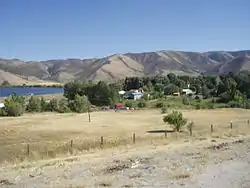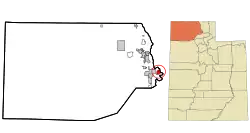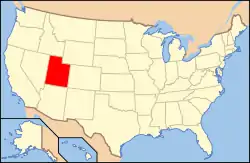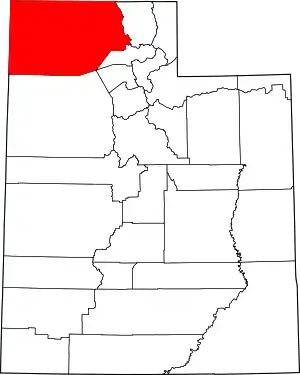Mantua, Utah
Mantua (/ˈmæntəweɪ/ MAN-tə-way or /ˈmænəweɪ/ MAN-ə-way) is a town on the eastern edge Box Elder County, Utah, United States.[2] The population of the town was 687 at the 2010 census.
Mantua, Utah | |
|---|---|
 Mantua, as seen from US‑89/US‑91, September 2008 | |
 Location of Mantua within Box Elder County and within the State of Utah | |
 Location of Utah within the United States | |
| Coordinates: 41°29′51″N 111°56′32″W | |
| Country | United States |
| State | Utah |
| County | Box Elder |
| Settled | 1863 |
| Incorporated | 1911 |
| Named for | Mantua, Ohio |
| Area | |
| • Total | 5.70 sq mi (14.75 km2) |
| • Land | 4.91 sq mi (12.71 km2) |
| • Water | 0.79 sq mi (2.04 km2) |
| Elevation | 5,200 ft (1,585 m) |
| Population (2010) | |
| • Total | 687 |
| • Estimate (2019)[3] | 963 |
| • Density | 196.25/sq mi (75.77/km2) |
| Time zone | UTC-7 (Mountain (MST)) |
| • Summer (DST) | UTC-6 (MDT) |
| ZIP code | 84324 |
| Area code(s) | 435 |
| FIPS code | 49-47840[4] |
| GNIS feature ID | 1443141[2] |
| Website | www |
Description

Mantua was settled in the mid-19th century when members of The Church of Jesus Christ of Latter-day Saints were sent by Lorenzo Snow to the valley to grow flax. The first group arrived in Mantua in 1863, and were all emigres from Denmark and their local leader was Hans Jens Jensen. Snow was from Mantua, Ohio, and the town was named after the Ohio community in his honor.[5] Prior to receiving its current name, the community had various name, including: Box Elder Valley, Copenhagen, Flaxville, Geneva, Hunsaker Valley, Little Copenhagen, and Little Valley.[6][7]
Geography
Mantua lies at the head of Box Elder Canyon on the northern, western, and southern sides of the Mantua Reservoir.
According to the United States Census Bureau, the town has a total area of 5.6 square miles (15 km2), of which 4.9 square miles (13 km2) are land and 0.7 square miles (1.8 km2) (13.21%) is water.
Climate
According to the Köppen Climate Classification system, Mantua has a dry summer continental climate, abbreviated "Dsa" on climate maps.[8]
| Historical population | |||
|---|---|---|---|
| Census | Pop. | %± | |
| 1870 | 184 | — | |
| 1880 | 356 | 93.5% | |
| 1890 | 337 | −5.3% | |
| 1900 | 350 | 3.9% | |
| 1910 | 377 | 7.7% | |
| 1920 | 354 | −6.1% | |
| 1930 | 314 | −11.3% | |
| 1940 | 319 | 1.6% | |
| 1950 | 271 | −15.0% | |
| 1960 | 275 | 1.5% | |
| 1970 | 413 | 50.2% | |
| 1980 | 484 | 17.2% | |
| 1990 | 665 | 37.4% | |
| 2000 | 791 | 18.9% | |
| 2010 | 687 | −13.1% | |
| 2019 (est.) | 963 | [3] | 40.2% |
| U.S. Decennial Census[9] | |||
Demographics
As of the census[4] of 2000, there were 791 people, 218 households, and 189 families residing in the town. The population density was 162.5 people per square mile (62.7/km2). There were 231 housing units at an average density of 47.5 per square mile (18.3/km2). The racial makeup of the town was 96.33% White, 0.63% African American, 0.51% Native American, 0.25% Asian, 0.51% from other races, and 1.77% from two or more races. Hispanic or Latino of any race were 0.88% of the population.
There were 218 households, out of which 52.8% had children under the age of 18 living with them, 79.4% were married couples living together, 5.0% had a female householder with no husband present, and 13.3% were non-families. 12.4% of all households were made up of individuals, and 5.5% had someone living alone who was 65 years of age or older. The average household size was 3.63 and the average family size was 4.01.
In the town, the population was spread out, with 38.2% under the age of 18, 10.1% from 18 to 24, 23.3% from 25 to 44, 20.1% from 45 to 64, and 8.3% who were 65 years of age or older. The median age was 30 years. For every 100 females, there were 108.7 males. For every 100 females age 18 and over, there were 103.8 males.
The median income for a household in the town was $60,234, and the median income for a family was $61,964. Males had a median income of $42,100 versus $26,875 for females. The per capita income for the town was $17,798. About 0.5% of families and 1.7% of the population were below the poverty line, including 2.1% of those under age 18 and 3.4% of those age 65 or over.
Government
Mantua is still considered by some to be a speed trap.[10][11] In 1997, its two police officers issued over 1,300 speeding tickets, amounting to fines of approximately $60,000, or more than half of the city's total yearly revenue.[12] In 2014, it issued over 2,100 traffic tickets, amounting to approximately $220,000 in fines, or more than one-third of total yearly revenue.[13] The sole full-time police officer (and now also mayor) objected to the term "speed trap" as he said he did not hide his truck, and fatal accidents have decreased since he began patrolling. Most tickets are issued along the town's section of U.S. Routes 89/91.[12] However, a state legislator counters that reduced speed limits, installed barriers, and rumble strips have reduced traffic fatalities, calling into question the justification for such a large ratio (compared to number of residents) of issued traffic tickets in the area.[13] In January 2020 Mantua once again came under fire for unethical revenue sources, as they were issuing parking tickets on land not owned by the city, and with signage knowingly being installed wrong. They had also increased their budget for parking fines 24% over the previous year. When questioned about this the city claims they lose money on parking tickets which is in contrast to the rest of the state. Brigham City owns the land which the tickets were written on, and the Mantua PD was operating with unapproved Brigham City employees telling them when to issue citations.
See also
- List of cities and towns in Utah
References
- "2019 U.S. Gazetteer Files". United States Census Bureau. Retrieved August 7, 2020.
- "Mantua". Geographic Names Information System. United States Geological Survey.
- "Population and Housing Unit Estimates". United States Census Bureau. May 24, 2020. Retrieved May 27, 2020.
- "U.S. Census website". United States Census Bureau. Retrieved 2008-01-31.
- Jenson, Andrew (1920). "Origin of Western Geographic Names". The Utah Genealogical and Historical Magazine. 11 (2): 83.
But in 1864 the settlement was named Mantua, after Mantua, Portage County, Ohio, the birthplace of President Lorenzo Snow.
- Van Cott, John W. (1990). Utah Place Names: A Comprehensive Guide to the Origins of Geographic Names: A Compilation. Salt Lake City: University of Utah Press. p. 244. ISBN 978-0-87480-345-7. OCLC 797284427.
- "Town of Manuta: Mantua History". townofmantua.com. Town of Mantua. Retrieved 17 Mar 2018.
- "Mantua, Utah Köppen Climate Classification (Weatherbase)". Weatherbase. Retrieved October 2, 2019.
- "Census of Population and Housing". census.gov. United States Census Bureau. Retrieved 4 Jun 2015.
- Davidson, Lee (24 Feb 2016). "Utah Senate votes to crack down on Mantua 'speed trap' in Box Elder County: SB100 would allow no city to generate more than 25% of its budget from speeding fines". The Salt Lake Tribune. Salt Lake City: Huntsman Family Investments, LLC. Retrieved 17 Mar 2018.
- "Most likely spots in Utah for speeding tickets". www.ksl.com. Retrieved 2019-02-26.
- "Mantua boasts mean speed trap". Deseret News. Salt Lake City: Deseret Digital Media. The Associated Press. 10 Mar 1998. Retrieved 17 Mar 2018.
- Gefre, Clayton (30 Jan 2016). "Mantua fuming over speed trap bill". The Herald Journal. Logan, Utah: Adams Publishing Group. Retrieved 17 Mar 2018.

